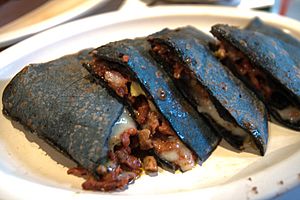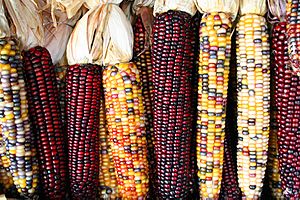Blue corn facts for kids
Blue corn, also known by names like Hopi maize or Tarahumara Maiz Azul, is a special type of corn grown in Mexico and the United States. It's a kind of flint corn, which means its kernels are hard and smooth. This unique corn is a key ingredient in many traditional foods, especially in Southern and Central Mexico, like the tasty tlacoyo.
Native American tribes, including the Hopi, Pueblo Indians, and Cherokee, first grew and developed blue corn. For the Hopi people, blue corn is still very important and is used to make traditional foods like piki bread. When blue corn is ground into a meal, it has a naturally sweet taste. It's also a popular ingredient in New Mexican cuisine, often used to make tortillas.


Contents
Types of Blue Corn
There are several different types, or "cultivars," of Hopi blue corn. Scientists studied five of these in the 1950s and found they had different heights, kernel sizes, and thicknesses. Their colors can range from almost black to a blue-grey. Some common names for these types include "sakwaqa'o" (standard blue), "huruskwapu" (hard blue), and "maasiqa'o" (grey-blue).
Traditional Hopi blue corn plants are usually short, growing only about 4 to 5 feet tall. They have deep roots, which helps them survive well in dry conditions. Other types, like the Rio Grande pueblo blue corn, grow taller (5–7 feet) and produce more corn, but they need more water. Both types grow best in deep, sandy soil.
Other native blue corn varieties include:
- Yoeme Blue: This type has small kernels and grows into a short, bushy plant (3 to 4 feet tall). It's very good at handling hot, desert weather and is grown by the Salt River Pima–Maricopa Indian Community in Arizona.
- Tarahumara Maiz Azul: This variety comes from the Tarahumara people in Northern Mexico. It's grown in high desert areas and is widely used to make tortillas and tamales. It's also used to make tesgüino, a traditional corn beer.
- Cherokee White Eagle Corn: This is a special type of blue corn from the Eastern Band of Cherokee Indians. It's a tall plant (5 to 7 feet) and produces a lot of corn. The seeds are shared with Cherokee tribal members from the Cherokee Nation Seed Bank.
Why Blue Corn is Healthy
Blue corn tortillas have more protein than yellow corn tortillas. For example, 100 grams of a specific blue corn tortilla (Sakwavikaviki) has 7.8% protein, while the same amount of yellow corn tortilla has 5.7%. This means blue corn can be a good source of protein!
The blue color in blue corn comes from special natural pigments called anthocyanins. These are the same pigments that give blueberries and purple grapes their color. Anthocyanins are a type of polyphenol, which are good for your health. The most common anthocyanins in blue corn are cyanidin 3-glucoside, pelargonidin, and peonidin 3-glucoside.
How Blue Corn is Used
Besides being used in traditional dishes like tortillas and cereals, blue corn is also used in many modern food products. You might find blue corn chips or blue corn pancake mix in stores!
Blue Corn in Culture
For the Hopi people, corn is very important in their religious ceremonies. They connect different colors of corn with different directions. Blue corn is linked to the Southwest direction. Yellow corn is for the Northwest, red corn for the Southeast, and white corn for the Northeast. Black corn is for "Above," and corn with all colors is for "Below."
See also
 In Spanish: Maíz azul para niños
In Spanish: Maíz azul para niños



